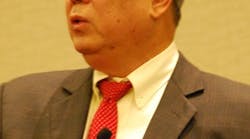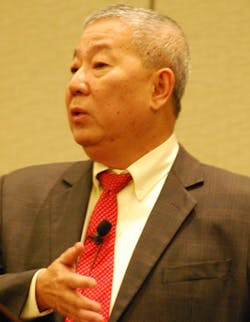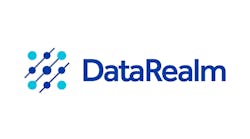The 2014 Yokogawa Users Group Conference and Exhibition, held in Houston on Sept 9-11, saw 500 registrants from 160 companies and 10 countries outside North America in attendance. That's a 40% increase over the prior event in 2012.
The meeting featured keynotes from Satoru Kurosu, director, executive vice president, Solution Service Business Headquarters, president and CEO of Yokogawa Electric Japan International Pte. Ltd.; retired process engineer and executive Simon Lam; and Chet Mroz, president and CEO, Yokogawa Corp. of America. Kurosu greeted attendees and said that the United States is "a most important market" for Yokogawa with a history in the U.S. that dates back to the 1950s.
Retired process engineer business executive Simon Lam outlined the expectations end users have of their automation partners.
In his address, "Current Industry Challenges and Expectations for an Automation Partner," Lam set the theme for the conference, pointing out how the changing face of industrial automation (IA) to an accelerated and deeply integrated world means that users have a different set of expectations of their automation partners."The challenges now are: How do we maintain cost leadership through lowering expenses? How do we achieve safe production with increased scrutiny from the public? How do we get the maximum benefit out of our feedstock? How do we handle the dilution of our technical experiences and resources due to reduced technical know-how and people, and then manage change with improved human reliability?" said Lam. "Finally, we have to ask, is our IA vendor dealing with cost factors only, or do we have a strategic, value-added partner for growth?"
He outlined several essential end-user requirements. "At a minimum, we require a reliable DCS platform, but sitting on this platform, we need software packages that can make our whole IA system a power tool to achieve short- and long-term financial objectives. We must be able to use IA tools to reduce costs of maintenance through increased reliability; enhance safety with intelligent alarm management that ensures operational integrity; and use simulation software to further optimize production with tools we can use day to day that can also aid training. We also want to enhance training and retraining of operators by using more dynamic simulations because it's critical to keep operators trained and alert, instead of being unable to remember important start-up and shutdown procedures after six years have gone by."
Likewise, Lam adds that individual site managers expect IA suppliers to understand their unique business concerns and help them meet challenges by using their own industrial knowledge and awareness of processes and products. "Site managers don't think suppliers have to know everything, but they also don't want someone to look at them with a blank face," said Lam. "They just want someone who will really try to work with them. These days, we're driven to collaborate collectively with consultants and IA suppliers to secure the right business architectures, embedded know-how and best practices to run sustainable, competitive businesses. This means we have to maintain long-term relationships with our suppliers just as we provide the human resources needed to supplement our own business units."
Chet Mroz provided a perspective on the Americas business, reminding listeners that the company announced a new global organization this year that separates Industrial Automation and Solution Service businesses, and gives the both direct access to Yokogawa corporate resources and attention. In the Americas, strong growth in systems and advanced analytical solutions have driven 18% annual growth since 2009, almost doubling total revenues to $425 million in 2013.





